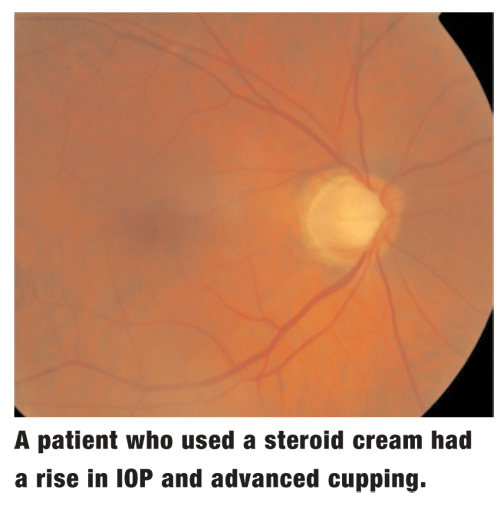 Q: I have a patient whose dermatologist has prescribed a steroid cream for use on the face and eyelids. Should I be concerned about a possible steroid IOP response? What should I say to the dermatologist?
Q: I have a patient whose dermatologist has prescribed a steroid cream for use on the face and eyelids. Should I be concerned about a possible steroid IOP response? What should I say to the dermatologist?
A: That familiar phrase applies here: Its not rare if its in your chair. The bottom line is that any time youre using steroids around the eye, the possibility of transdermal absorption is always there, says Randall Thomas, O.D., of
Although secondary ocular hypertension from a steroid eyelid cream is unlikely, he says, Its possible that enough of the drug is absorbed into the eye in sufficient quantities to raise the intraocular pressure in a steroid responder.
According to one report of three such cases, topical corticosteroids used for dermatological conditions around the face and eyes are often regarded as being fairly innocuous with regard to ocular side-effects [But] secondary open-angle glaucoma can be a sight-threatening consequence, and periorbital steroids should therefore be used cautiously and sparingly, particularly in those with a family history of glaucoma. Intraocular pressure may not always return to normal upon cessation of the drug.1
Dermatologists routinely prescribe steroid skin creams for chronic treatment of many dermatoses, particularly for severe atopic eczema. Know the common onessuch as Dermatop (prednicarbate, Dermik Labs), clobetasol and fluocinonideso that you recognize their potential danger.
 One case report described a 29-year-old woman who used potent topical steroids for long periods throughout most of her life for severe eczema, including to the periorbital region.2 After one such month-long application, she presented to her ophthalmologist with severe bilateral glaucoma and irreversible visual loss attributed to the steroid use.2
One case report described a 29-year-old woman who used potent topical steroids for long periods throughout most of her life for severe eczema, including to the periorbital region.2 After one such month-long application, she presented to her ophthalmologist with severe bilateral glaucoma and irreversible visual loss attributed to the steroid use.2
How an ocular hypertensive response actually happens from an ointment on the eyelids remains unclear. The response could be related to systemic absorption of corticosteroid through the skin of the eyelid.3 Alternatively, a sufficient amount of ointment could seep over the eyelid and on to the ocular surface to cause the rise in IOP, similar to the application of topical ophthalmic corticosteroids.3
Still, patients with blepharodermatitis would not likely use a steroid ointment for longer than a week or two, and thats about how long it would take for an adult whos a steroid-responder to develop secondary IOP rise, Dr. Thomas says.
But, be aware that secondary ocular hypertension from topical steroids can develop more rapidly and more severely in children. Indeed, children (especially children age five and under) can develop elevated IOP from a dermatologic eyelid ointment in as few as four days.3,4
The immediate solution is simply to discontinue the steroid cream, Dr. Thomas says. Have the patient return in a week or two to recheck the IOP. If the pressure still remains up, you would treat it as you would any other glaucoma, he says.
In the meantime, call or write to the dermatologist who prescribed the ointment and explain the problem, Dr. Thomas says. If a steroid ointment is needed in the future, consider fluorometholone ophthalmic ointment, which is not as likely as dexamethasone ointment to raise intraocular pressure.5
1. Garrott HM, Walland MJ. Glaucoma from topical corticosteroids to the eyelids. Clin Experiment Ophthalmol 2004 Apr; 32(2):224-6.
2. Sahni D, Darley CR, Hawk JL. Glaucoma induced by periorbital topical steroid usea rare complication. Clin Exp Dermatol 2004 Nov;29(6):617-9.
3. Chua JK, Fan DS, Leung AT, Lam DS. Accelerated ocular hypertensive response after application of corticosteroid ointment to a childs eyelid. Mayo Clin Proc. 2000 May;75(5): 539.
4. Lee YJ, Park CY, Woo KI. Ocular hypertensive response to topical dexamethasone ointment in children. Korean J Ophthalmol 2006 Sep;20(3):166-70.
5. Kass M, Cheetham J, Duzman E, Burke PJ. The ocular hypertensive effect of 0.25% fluorometholone in corticosteroid responders. Am J Ophthalmol 1986 Aug 15;102(2): 159-63.

